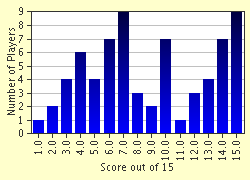Quiz Answer Key and Fun Facts
1. One imagines that his agent looked at his real name and said, "Well, that will never fit on a marquee. We'll have to change it." What was Bogarde's real name?
2. What was Bogarde doing during World War II?
3. Bogarde appeared as an extra in a 1939 George Formby film 'Come on George!', and it was not until 1947 that he actually got a speaking part. What was the name of the film?
4. The film that made Bogarde a star came along in 1949. It co-starred Jack Warner, Jimmy Hanley and Patrick Doonan, and it was a crime drama. What was it?
5. One of my favourite Bogarde films was made in 1950, when he co-starred with Jean Simmons in 'So Long at The Fair'. Where was the action set?
6. In 1954, Bogarde appeared in the first of several comedies based on books by Dr. Richard Gordon. In this first movie, he played a rather diffident medical student.
7. Dirk Bogarde made only one foray into Hollywood, to make a movie with French actress Capuccine. The movie was called 'Song Without End' (1960), and it was a biopic of a famous composer. Which one?
8. In 1961, Bogarde starred in a film that ultimately led to a change in British law. What was the film?
9. While Dirk Bogarde never 'came out', he was held, even during his lifetime, to be a homosexual. What was the name of his partner?
10. Following his partner's death in 1988 after a painful and debilitating bout with cancer, Bogarde took up a specific cause. What was it?
11. Apart from acting, what other creative talents did Bogarde have?
12. In 1990, a famous American pop star, claiming that his film 'The Night Porter' had been her inspiration, approached Bogarde to appear in her new music video. Bogarde declined. Who was the star?
13. Who directed Bogarde in 'The Night Porter'?
14. Bogarde was honoured in a specific way in 1992. How?
15. Where was Dirk Bogarde living when he died?
Source: Author
Cymruambyth
This quiz was reviewed by FunTrivia editor
Nannanut before going online.
Any errors found in FunTrivia content are routinely corrected through our feedback system.

